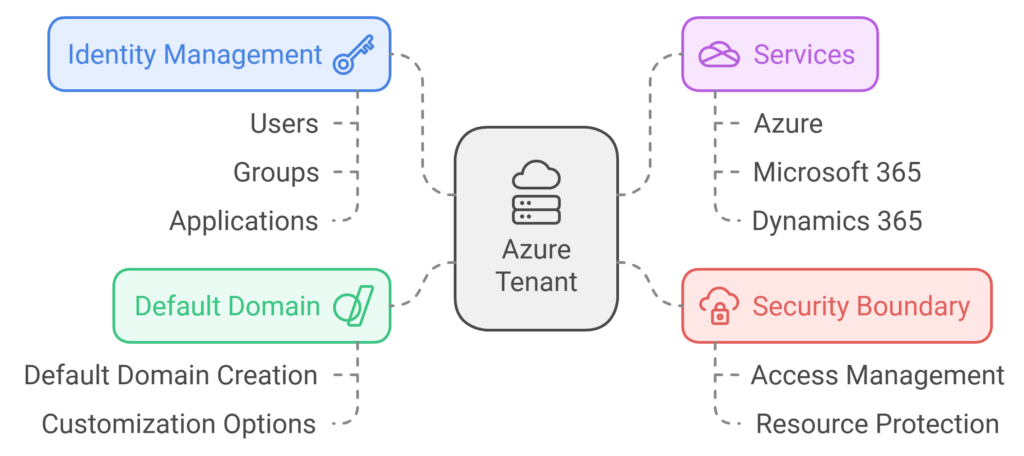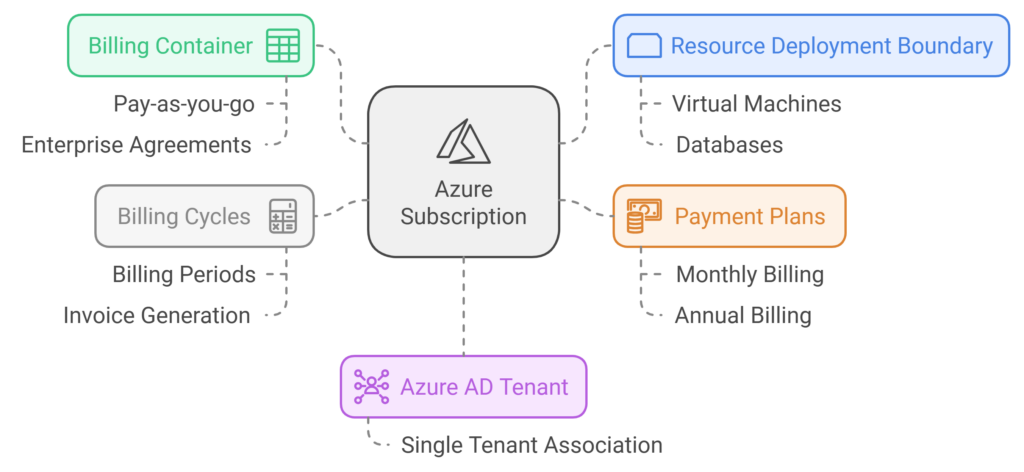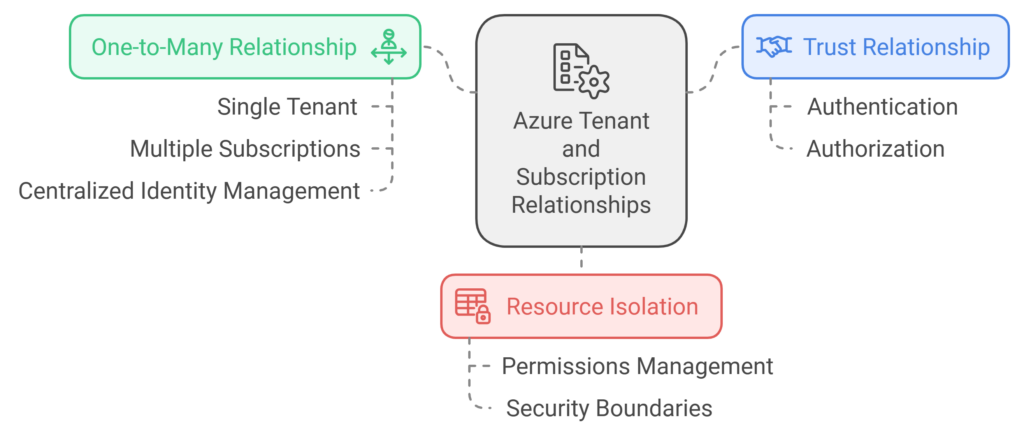Azure Tenant vs Azure Subscription: A Comprehensive Guide for 2024
Understanding the difference between Azure tenant and subscription is crucial for anyone working with Microsoft Azure. In this comprehensive guide, we’ll explore these concepts with practical examples and expert insights.
What is an Azure Tenant?
An Azure Tenant is your organization’s dedicated instance of Azure Active Directory (Azure AD). It’s the security boundary for your cloud resources and serves as the foundation of your Azure identity management. Microsoft assigns to an organization when it signs up for any Microsoft cloud service like Azure, Microsoft 365, or Dynamics 365.
The Azure Tenant acts as a directory where users, groups, and applications are managed. It provides identity and access management services, allowing organizations to manage access to resources securely.
A tenant is automatically created when you sign up for a Microsoft cloud service, and it includes a default domain (e.g., yourcompany.onmicrosoft.com), which can be customized later on.
Example: Contoso Corporation has an Azure tenant with the domain ‘contoso.onmicrosoft.com‘. This tenant:
- Stores all employee credentials
- Manages access permissions
- Controls single sign-on settings
- Houses their Microsoft 365 services
Key Tenant Features:
- Global admin control
- Multi-factor authentication settings
- Conditional access policies
- Directory synchronization with on-premises Active Directory
What is an Azure Subscription?
An Azure subscription is your billing container and resource deployment boundary, it is kind of logical container for provisioning and managing resources in Azure. It’s where you create, manage, and pay for your Azure services.
Each subscription is associated with one Azure AD tenant and contains all the resources deployed in Azure, such as virtual machines, databases, etc.
Subscriptions are linked to payment plans (e.g., pay-as-you-go or enterprise agreements) and have their own billing cycles.
Example: Contoso Corporation maintains several subscriptions:
- “Contoso-Production” – For live applications
- “Contoso-Development” – For testing and development
- “Contoso-Marketing” – Dedicated to marketing department resources
Each subscription:
- Has its own billing cycle
- Includes detailed cost reporting
- Can be paused or canceled independently
- Has specific resource quotas and limits
Understanding the Relationship Between Tenant and Subscription: Real-World Examples
Let’s look at how tenants and subscriptions work together:
- Trust Relationship: An Azure subscription has a trust relationship with an Azure AD tenant. This means that the subscription relies on the tenant for authentication and authorization of users, groups, and applications.
- One-to-Many Relationship: A single tenant can manage multiple subscriptions. However, each subscription is associated with only one tenant. This allows organizations to separate billing or resource management for different projects or departments while maintaining centralized identity management.
- Resource Isolation: Resources within one subscription are isolated from those in another subscription, even if they are under the same tenant. This isolation helps in managing permissions and security boundaries effectively.
Here in this first example our Contoso corporation has only 1 tenant (which is usual) contoso.com and isolated workloads based on their functional level (like separation of Production, Development from Marketing) and also environmental level like Production and Development subscriptions.
Example 1: Enterprise Setup
Contoso Corporation
├── Azure Tenant (contoso.com)
├── Production Subscription
├── Web Apps
├── Databases
└── Virtual Machines
├── Development Subscription
├── Test Environments
└── DevOps Tools
└── Marketing Subscription
├── Content Management Systems
└── Analytics ToolsHere in this second example, we have small company or startup, didn’t pay much attention and not using “Management Groups” which gives extra layer and flexibility in Azure resource management. They have created one subscription, deployed everything into that and attached to Tenant directly :), don’t do that!
Example 2: Startup Setup
TechStartup Inc
├── Azure Tenant (techstartup.com)
└── Single Subscription
├── Web Application
├── Database
└── StorageKey Differences Deep Dive
- Administrative Scope
- Tenant: Global administrative control
- Subscription: Resource and service management
- Cost Management
- Tenant: No direct costs
- Subscription: All Azure service costs and billing
- Resource Organization
- Tenant: Identity and access management
- Subscription: Resource deployment and management
Advanced Management Scenarios
Cross-Subscription Access
You can grant users access across subscriptions using:
- Role-Based Access Control (RBAC)
- Management Groups
- Resource sharing policies
Example RBAC Assignment in PowerShell:
# Assign contributor role to a user for a subscription
New-AzRoleAssignment -SignInName user@contoso.com `
-RoleDefinitionName "Contributor" `
-Scope "/subscriptions/<subscription-id>"Resource Organization Best Practices
It is always recommended to use “Management Groups” as extra layer of functional separation and giving more breath room when managing workloads, teams and different environments in Azure.
- Management Groups Structure:
Root Management Group
├── Production Management Group
│ ├── Production Subscription
│ └── DR Subscription
└── Non-Production Management Group
├── Development Subscription
└── Test Subscription2. Naming Convention Example:
Maintaining consistent naming conventions for Azure resources plays a crucial role in creating and sustaining a manageable and organized environment, making it easier to navigate and maintain. Here you can find an example naming convention;
<company>-<environment>-<region>-<resource-type>-<instance>
Example: contoso-prod-eastus-vm-001Common Scenarios and Solutions
If you have multiple environments, it is better to separate each environment and deploy resources to their individual subscriptions in Azure.
It will isolate resources also give more granular view, chargeback possibilities with different cost structure.
- Multiple Environments
- Development
- Staging
- Production
- Each in separate subscriptions but under the same tenant
- Cost Separation
- Different departments
- Different projects
- Different billing centers
Frequently Asked Questions FAQ
Q: Can I have multiple tenants?
A: Yes, but most organizations only need one tenant.
Q: How many subscriptions can I have?
A: You can have multiple subscriptions within a tenant.
Q: Can I transfer resources between subscriptions?
A: Yes, most Azure resources can be moved between subscriptions within the same tenant.
Q: How do I manage costs across multiple subscriptions?
A: Use Azure Cost Management + Billing and set up budgets and alerts.
Q: Can I link an existing subscription to a different tenant?
A: Yes, but it requires administrative access and careful planning.
Official Documentation References
- Azure Tenant Documentation:
- Azure Subscription Documentation:
Conclusion
Understanding the relationship between Azure tenants and subscriptions is fundamental to building a well-organized cloud infrastructure. By properly structuring your tenant and subscriptions, you can better manage access, control costs, and organize resources effectively.
If you have any questions or need assistance, feel free to reach out or leave a comment below!






